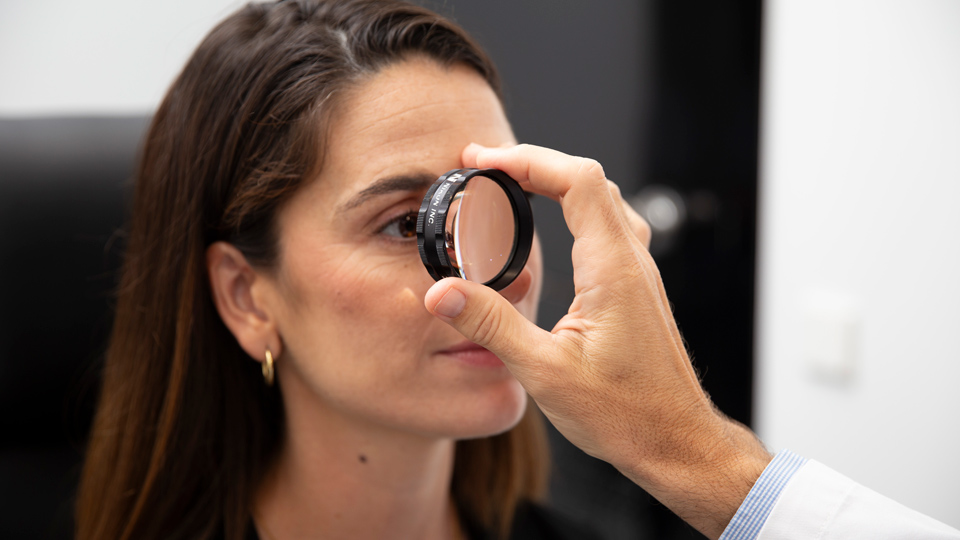How to Protect Your Eyes from Sandstorms and UV Damage in the UAE
18/04/2025

15/08/2024
Diabetes is a chronic condition that affects millions globally, characterized by elevated blood sugar levels that can lead to a range of health complications. One of the most critical areas impacted by diabetes is eye health. Elevated glucose levels can damage the delicate blood vessels in the eyes, leading to serious conditions such as diabetic retinopathy, macular edema, and even blindness if left untreated.
1) Why people with type 1 and type 2 diabetes are at a heightened risk for eye complications and peripheral neuropathy?
People with diabetes are at risk for eye complications and peripheral neuropathy because metabolic changes related to high blood sugar levels can damage blood vessels and nerves. In the eye, this can lead to conditions like diabetic retinopathy, where the blood vessels in the retina (the light-sensitive part of the eye) become damaged. Vascular damage can affect the retina causing diabetic macular edema, vitreous hemorrhage and retinal detachments which can affect vision and at times can lead to blindness if left untreated. Peripheral neuropathy affects the nerves, especially in the legs and feet, leading to numbness, pain, and sometimes serious infections. Early management blood sugar levels through diet, exercise, and medication can help reduce these risks over time.
2) Can diabetes lead to blindness?
Yes, diabetes can lead to blindness in some patients. The main cause is diabetic retinopathy, a condition where high blood sugar levels damage the blood vessels in the retina. Patients with diabetic retinopathy in early stages are usually asymptomatic, but over time, progressive damage can lead to vision loss if left untreated. Other eye conditions like cataracts (clouding of the lens) and glaucoma (increased pressure in the eye) are also more common in people with diabetes and can affect vision as well. For this matter, we advise patients with diabetes to visit the ophthalmologist at least yearly for regular eye exams, this is to prevent progression of the condition and to treat it early if required to prevent visual loss or blindness. It is important to note that controlling blood sugar levels and other comorbidities are crucial in preventing progression of the disease and protect vision.
3) How prevalent is the case of diabetic patients having eye problems?
Eye problems are quite common among people with diabetes.
Statistics show that about 30% of adults over the age of 40 with diabetes have diabetic retinopathy, which is approximately 7.7 million people in the United States alone. This number is expected to increase to around 14.6 million by 2050. The World Health Organization (WHO) estimates that diabetic retinopathy is responsible for 2.6% of global blindness, currently affecting an estimated 2.2 million people.
In addition to diabetic retinopathy, people with diabetes are 2-5 times more likely to develop cataracts. Around 20% of diabetes patients have cataracts by the time they are diagnosed. Diabetic patients also are twice as likely to develop glaucoma compared to those without diabetes, about 5% of people with diabetes have glaucoma.
These statistics highlight the importance of regular eye exams and proper diabetes management to prevent and treat these common eye problems
4) Can we cite a case study of a patient whose eyes were affected by diabetes?
Many patients experience vision loss due to complications from diabetic retinopathy, but with timely diagnosis and treatment, many can regain their sight.
Let me share the story of Ahmed, one of my patients. Ahmed is a 58-year-old truck driver who has lived with type 2 diabetes for 20 years. While he managed his blood sugar levels moderately well at home during the last 2 years, he hadn't visited the eye clinic for eight years. Recently, he came in after suddenly losing vision in his right eye which drastically affected his daily life. He couldn't drive anymore, which was a significant problem since it was his livelihood.
During the examination, we discovered a moderate hemorrhage in the vitreous cavity of his right eye and advanced diabetic retinopathy in the left eye. Ahmed was understandably devastated and worried about his ability to return to work, as it was his only source of income. We advised him to take a three-week sick leave and recommended an injection in his right eye and laser treatment in both eyes to prevent the disease's progression.
Fortunately, after the hemorrhage cleared, Ahmed's vision fully recovered without the need for surgery, and he was able to return to work. We stressed the importance of regular follow-ups and urged him to see his endocrinologist for stricter blood sugar control.
Ahmed's experience underscores the importance of regular eye check-ups and effective diabetes management to prevent severe eye complications. Vision loss in one or both eyes can significantly impact a person's ability to carry out daily tasks. Thankfully, Ahmed's condition was not too advanced, allowing for a full recovery without surgery.
5) Why must diabetic patients do an eye check-up every year?
The American Diabetes Association reports that almost all individuals with type 1 diabetes and over 60% of those with type 2 diabetes will develop some form of diabetic retinopathy within 20 years of their diagnosis. This statistic highlights the critical importance of annual eye check-ups for diabetic patients. Many diabetes-related eye conditions, such as diabetic retinopathy, often have no symptoms in their early stages. Regular eye exams are essential because they enable doctors to detect and address problems before they progress to more severe complications, including blindness. Yearly check-ups are crucial for monitoring any changes in eye health and ensuring timely interventions to protect vision. Consistent eye care, coupled with effective blood sugar control, is vital for maintaining healthy eyesight in individuals with diabetes.
Dr. Wissam